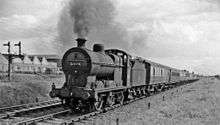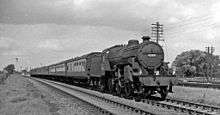Syston and Peterborough Railway
The Syston and Peterborough Railway was an early railway in England opened between 1845 and 1848 to form a branch from the Midland Counties Railway at Syston just north of Leicester to Peterborough.
| Stations |
|---|
|
Syston |
Origins
Most new railways, particularly those of the Midland, were built for transporting coal, and so could show a quick return on investment. A line from Leicester to Peterborough had been floated as an independent scheme which might not have progressed, even though there had been a famine of coal in the area. At Stamford for instance it had risen to forty shillings a ton. However, because of the railway politics of the time, it was supported by George Hudson who was involved with the Midland Counties Railway which, was in the process of merging into the new Midland Railway.
The Midland at that time was the main line from London to the North East of England, via Derby, Leeds and York. The Midland adopted the line ‑ along with the Nottingham to Lincoln Line ‑ as part of urgent moves to hinder the expansion of the Northern and Eastern Railway northwards from London to York.

Preparation
The route was surveyed in 1844, and plans lodged with the various county offices on 30 November. The engineers for the line were George Stephenson and Charles Liddell. The surveyor was J.G. Binns. The cost estimate was £700,000, or £15,000 a mile.[1]
Even before the Act was passed there were problems where the line approached the estate of the Earl of Harborough. The original plan was to follow the course of the Wreake through Stapleford Park. Not only did the Earl refuse to sell the land, he put up notices forbidding the surveyors entry to the Park. A group of surveyors, walking along the towpath of the Oakham Canal, were confronted by Lord Harborough's men and ordered to return to where they had come from. Since it was a public right of way, the surveyors refused, whereupon they were arrested and put in a cart, presumably to be taken before a magistrate. They were stopped by a policeman who pointed out that the surveyors were in the right, so they were simply tipped out into the road.
In what became known as the "Battle of Saxby", the Midland Railway men returned with reinforcements, to meet a similarly enlarged force of estate workers. The railwaymen were chased away but returned two days later, early in the morning, to find Harborough's men waiting for them once more. The mayhem came to the attention of the authorities, who imprisoned some of the Midland men and fined some estate workers for damage to surveying equipment.[2]
In spite of his Lordship's opposition, however, the Syston and Peterborough Railway Act was passed on 30 June 1845.
Construction
From the junction at Syston, the line went first north-eastwards towards Asfordby then swung to the east to Melton Mowbray along the valley of the Wreake then along the River Eye. It was at this point, where the intention was to travel south towards Oakham, that the line encountered Stapleford Park.
The law was now firmly on the Midland side, but Lord Harborough continued his opposition. Even though the Act included an amendment which would take them further away, there was another brawl which resulted in him driving his carriage full tilt into the railwaymen,
This amendment included a tunnel under the Cuckoo plantation, his Lordship's favourite part of the park. Unfortunately it collapsed during construction, and most of the spinney fell into it. The Earl was furious and a further Act of Parliament in 1847 arranged for yet another deviation.[3]
From Oakham, the line skirted the Vale of Catmose (part of which was later flooded to form Rutland Water). It then turned eastwards along the River Chater. At Luffenham it was joined by the Rugby and Stamford Railway which the LNWR was building at the same time and had been granted running rights into Stamford.
From Stamford it then curved southwards to meet the Eastern Counties Railway at Peterborough. While most of the line opened in 1846, the problems at Stapleford Park delayed this section for another two years.
Later history

By 1879 the Midland's main line through Leicester was becoming overcrowded. From London as far as Kettering the line was quadrupled, but northwards the Midland took the opportunity of diverting through Manton (the Oakham to Kettering Line )to give both Oakham and Melton Mowbray a direct London service, proceeding thence to Nottingham by what became known as the "Melton Line".
The curve around Stapleford Park was a nuisance for the express trains and, in 1880 when the Midland and Great Northern Joint Railway built a branch from Bourne in Lincolnshire to Saxby, the opportunity was taken to reduce the curve with Saxby station being moved in the process. Lord Harborough had died in the meantime and the estate had been bought by Lord Gretton of Burton upon Trent, who was more sympathetic to the railway. The Midland had, after all, made his fortune by taking his beer all over the country and, indeed, his son was later to build the Stapleford Miniature Railway within the park.
In 1882 the Midland built a branch line from Ashwell to Cottesmore to service iron ore extraction with an exchange sidings. This is now the site of the Rutland Railway Museum. Of note also are the stations at Helpston and Walton. When the GNR built its line north from Peterborough to Grantham in 1853, it ran next to the Midland line but, in return for the latter's transport of materials, agreed not to build competing stations.
Although most of the branches are gone, or at least no longer support regular passenger services, the Syston and Peterborough Railway is still in daily use as part of the Birmingham to Peterborough Line
The advent of Google Earth has meant that what is still known as "Lord Harborough's Curve", as well as the trackbed of the M&GNR branch, at Saxby can clearly be seen.
References
- Williams, F.S., (1874) The Midland Railway: Its Rise and Progress Derby: Bemrose and Son
- Kingscott, G., (2006) Lost Railways of Leicestershire and Rutland, Newbury: Countryside Books
- Anderson, P.H., (1985 2nd ed) Forgotten Railways Vol 2: The East Midlands, Newton Abbot: David and Charles